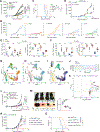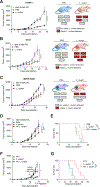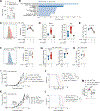Dietary tryptophan metabolite released by intratumoral Lactobacillus reuteri facilitates immune checkpoint inhibitor treatment
- PMID: 37028428
- PMCID: PMC10148916
- DOI: 10.1016/j.cell.2023.03.011
Dietary tryptophan metabolite released by intratumoral Lactobacillus reuteri facilitates immune checkpoint inhibitor treatment
Abstract
The use of probiotics by cancer patients is increasing, including among those undergoing immune checkpoint inhibitor (ICI) treatment. Here, we elucidate a critical microbial-host crosstalk between probiotic-released aryl hydrocarbon receptor (AhR) agonist indole-3-aldehyde (I3A) and CD8 T cells within the tumor microenvironment that potently enhances antitumor immunity and facilitates ICI in preclinical melanoma. Our study reveals that probiotic Lactobacillus reuteri (Lr) translocates to, colonizes, and persists within melanoma, where via its released dietary tryptophan catabolite I3A, it locally promotes interferon-γ-producing CD8 T cells, thereby bolstering ICI. Moreover, Lr-secreted I3A was both necessary and sufficient to drive antitumor immunity, and loss of AhR signaling within CD8 T cells abrogated Lr's antitumor effects. Further, a tryptophan-enriched diet potentiated both Lr- and ICI-induced antitumor immunity, dependent on CD8 T cell AhR signaling. Finally, we provide evidence for a potential role of I3A in promoting ICI efficacy and survival in advanced melanoma patients.
Keywords: Lactobacillus reuteri; aryl hydrocarbon receptor; immune checkpoint inhibitor; indole-3-aldehyde; melanoma; microbial AhR ligands; microbial-host crosstalk; tryptophan; tumor microbiome.
Copyright © 2023 Elsevier Inc. All rights reserved.
Conflict of interest statement
Declaration of interests D.A.A.V.: cofounder and stock holder—Novasenta, Tizona, Trishula; stock holder—Oncorus, Werewolf; patents licensed and royalties—Novasenta, BMS; scientific advisory board member—Tizona, Werewolf, F-Star, Bicara, Apeximmune, T7/Imreg Bio; consultant—BMS, Almirall, Incyte, G1 Therapeutics, Inzen Therapeutics, Regeneron, Avidity Partners; research funding—BMS, Novasenta. A.V.J.: research funding—Mitsubishi Tanabe Pharma. J.F.P.: cofounder and stock holder—Gateway Biome Corporation. D.D.: grants/research support (institutional)—Arcus, CellSight Technologies, Immunocore, Merck, Regeneron Pharmaceuticals Inc., Tesaro/GSK; consultant: Clinical Care Options (CCO), Finch Therapeutics, Gerson Lehrman Group (GLG), Medical Learning Group (MLG), Xilio Therapeutics; CE Speakers’ Bureau—Castle Biosciences; intellectual Property includes US Patent 63/124,231, “compositions and methods for treating cancer,” December 11, 2020 and US Patent 63/208,719, “compositions and methods for determining responsiveness to immune checkpoint inhibitors (ICIs), increasing effectiveness of ICI and treating cancer,” June 9, 2021.
Figures







Comment in
-
Translocating Lactobacillus torments tumors via tryptophan catabolism.Cell. 2023 Apr 27;186(9):1821-1823. doi: 10.1016/j.cell.2023.03.022. Cell. 2023. PMID: 37116468
-
Probiotics promote local antitumour immunity.Nat Rev Immunol. 2023 Jun;23(6):343. doi: 10.1038/s41577-023-00882-w. Nat Rev Immunol. 2023. PMID: 37117601 No abstract available.
References
Publication types
MeSH terms
Substances
Grants and funding
- R21 AI163721/AI/NIAID NIH HHS/United States
- P50 CA254865/CA/NCI NIH HHS/United States
- U01 CA272541/CA/NCI NIH HHS/United States
- P30 CA047904/CA/NCI NIH HHS/United States
- R21 CA259636/CA/NCI NIH HHS/United States
- P20 GM103418/GM/NIGMS NIH HHS/United States
- R56 AI168478/AI/NIAID NIH HHS/United States
- F32 CA247004/CA/NCI NIH HHS/United States
- T32 AI089443/AI/NIAID NIH HHS/United States
- R01 DK130897/DK/NIDDK NIH HHS/United States
- U01 CA268806/CA/NCI NIH HHS/United States
- R01 DK129950/DK/NIDDK NIH HHS/United States
- T32 CA082084/CA/NCI NIH HHS/United States
- R01 CA253329/CA/NCI NIH HHS/United States
- S10 OD023402/OD/NIH HHS/United States
- R01 CA222203/CA/NCI NIH HHS/United States
- R01 CA203689/CA/NCI NIH HHS/United States
- P01 AI108545/AI/NIAID NIH HHS/United States
LinkOut - more resources
Full Text Sources
Other Literature Sources
Medical
Molecular Biology Databases
Research Materials

